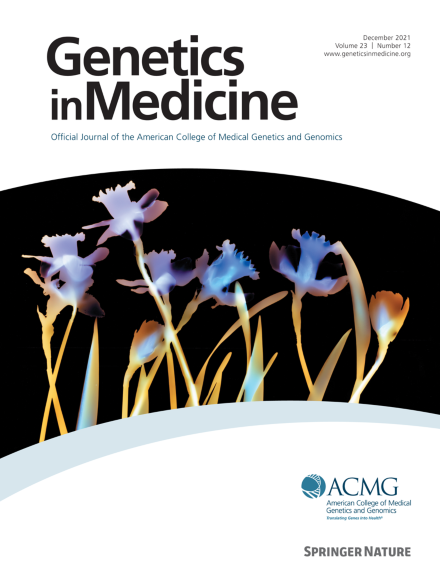Optical genome mapping improves clinical interpretation of constitutional copy-number gains and reduces their VUS burden
IF 6.2
1区 医学
Q1 GENETICS & HEREDITY
引用次数: 0
Abstract
Purpose
Genomic structure of copy-number gains is critical for their clinical interpretation but cannot be determined by chromosomal microarray (CMA) analysis, which does not provide information about chromosomal location and orientation of multiplied regions. We thus hypothesized that in CMA testing gains have higher probability than losses to be classified as variants of uncertain significance (VUS) and that structural information from optical genome mapping (OGM) may improve their interpretation.
Methods
Using a χ2 test, we assessed the association between classification of copy-number variants as VUS and their type (gains vs losses) in a cohort of 4073 CMA cases. Thirty-three VUS gains involving disease-associated genes were characterized by OGM to evaluate if OGM data enable their more conclusive clinical interpretation.
Results
The proportion of variants reported as VUS compared with likely pathogenic/pathogenic was significantly higher for gains than losses, confirming their increased VUS burden. OGM successfully determined genomic structure for all 33 copy-number gains, showing that 26 of 33 were tandem duplications and 7 of 33 were complex rearrangements. Structural information facilitated clinical interpretation in majority of the cases; it supported benign nature for 27 of 33 gains and was inconclusive or supported pathogenic role for 6 of 33. An estimated 20% of reported VUS gains would not have been reportable if we had OGM data.
Conclusion
We illustrate a specific advantage of OGM compared with CMA: in addition to detecting both copy-number variants and balanced rearrangements, OGM improves clinical interpretation of copy-number gains by providing structural information and is thus expected to significantly decrease their VUS burden.
光学基因组定位提高了体质拷贝数增益的临床解释,并减少了他们的VUS负担。
目的:拷贝数增益的基因组结构对其临床解释至关重要,但不能通过染色体微阵列(CMA)分析来确定,该分析不能提供关于染色体位置和倍增区域方向的信息。因此,我们假设在CMA测试中,增益比损失有更高的概率被分类为VUS,并且来自光学基因组图谱(OGM)的结构信息可能会改善它们的解释。方法:使用卡方检验,我们评估了4073例CMA病例中拷贝数变异分类为VUS及其类型(增益与损失)之间的关系。采用OGM对33例涉及疾病相关基因的VUS增益进行了表征,以评估OGM数据是否能够使其更具结论性的临床解释。结果:与可能致病性/致病性相比,报告为VUS的变异比例明显高于损失,证实了它们增加的VUS负担。OGM成功地确定了所有33个拷贝数增益的基因组结构,表明26/33是串联重复,7/33是复杂重排。大多数病例的结构信息有助于临床解释;27/33的增益支持良性,6/33的增益不确定或支持致病作用。如果我们有OGM数据,估计报告的VUS收益的20%将不会被报告。结论:我们展示了OGM与CMA相比的一个特殊优势:除了检测拷贝数变异和平衡重排外,OGM还通过提供结构信息改善了拷贝数增益的临床解释,因此有望显著减少他们的VUS负担。
本文章由计算机程序翻译,如有差异,请以英文原文为准。
求助全文
约1分钟内获得全文
求助全文
来源期刊

Genetics in Medicine
医学-遗传学
CiteScore
15.20
自引率
6.80%
发文量
857
审稿时长
1.3 weeks
期刊介绍:
Genetics in Medicine (GIM) is the official journal of the American College of Medical Genetics and Genomics. The journal''s mission is to enhance the knowledge, understanding, and practice of medical genetics and genomics through publications in clinical and laboratory genetics and genomics, including ethical, legal, and social issues as well as public health.
GIM encourages research that combats racism, includes diverse populations and is written by authors from diverse and underrepresented backgrounds.
 求助内容:
求助内容: 应助结果提醒方式:
应助结果提醒方式:


